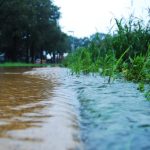In this article, we will walk you through everything you need to know about how to prevent sand fleas on dogs, so kindly keep reading.
Related: Veterinary Laser Therapy: The Science, Uses, and Benefits for Dogs
Where do the fleas come from?
Sand fleas are found in regions where there is salt and water that is contaminated. They thrive in humid environments with an abundance of water, such as marshes, beaches, and swamps.
They enjoy tropical environments and may be found in the US, South America, the Caribbean, Madagascar, and even Africa and more. They’re most typically seen on the beach in the United States.
They may, however, be present if you walk with your dog on nature paths or other recreational places. Sand fleas are more common in coastal areas than in other areas.
They have also been seen in arid locations.
Why do Dogs Get Sand Fleas?
Sand fleas may feed on both your dog and you if you are in a sandy or marshy location with your pet dog, whether on vacation or if you live close to or on a beach. Sand fleas often burrow into your dog’s skin to feast on their flesh and blood.
Sand fleas may also cause skin infections and skin disorders in your dog. So, if you live near the beach and your dog often enjoys the beautiful beach sand, keep reading to find out how to help your dog cope with sand fleas.
How are Dog, Human, and Animal Sand fleas different?
Because sand fleas feed on aquatic creatures, they are the only species that respond differently from domestic canines and people, who can be treated and freed of sand fleas. Sand fleas are very irritating if not treated, particularly to their watery prey.
Sand fleas normally target a water animal, remain on it, proliferate, and feast until the animal dies. This is uncommon in domesticated dogs because a dog with sand fleas can be treated.
What are the Symptoms of Sand fleas on a dog?
It’s not difficult to figure out. Sand fleas are very tiny.
After a day out with your dog, fleas will grip or their feet and start looking for places to eat. They’re translucent and hard to see. However, if your dog continually scratches, bites, or licks itself, he or she may have sand fleas that are very hurtful.
When fleas bite and feed on your dog’s blood, they cause severe itching and discomfort. They burrow through the skin, causing your dog to become insane after a long time of soaking in your it blood.
Signs of sand fleas on a dog include:
- Constant licking, biting, or clawing of his fur
- There are visible small black fleas on the body.
- During the bites, there may be yelping or barking.
- Its skin contains small rashes and bumps.
- Temperature rises
Related: Why Small Breed Dogs Make for Good Gamer Pets
Ways of Protecting Your Dog of Sand Fleas
There are many ways to get rid of sand fleas. You may first test the methods listed below to ensure their effectiveness.
If none of these works, take your dog to the veterinarian for treatment to sure its fine concerning it health.
Clean your Home Effectively
Clean your house to guarantee the sand fleas are eliminated and to avoid the possibility of a new flea infestation.
This includes doing anything you can to eliminate the pests that may be hidden in your house. Treat the area where your dog has been as though there are fleas present.
Follow the next instruction given below to ensure effective cleaning:
- Vacuum the carpet, furniture, bedding, drapes, and other materials.
- To get rid of sand fleas in high-traffic areas where your dog hangs out, use a steam cleaner.
- Laundry all of your clothes from the day you went out.
- Sterilize your laundry hamper
Salt
You may sprinkle normal table salt in locations where you suspect sand fleas are located. This will dry up the fleas and destroy them without requiring any effort on your part. It is also safe, natural, and simple to clean.
After a week, just vacuum up the salt. You’ll probably suck up all the dead sand fleas as well, so that’s nice.
This is one of the simplest methods for removing sand fleas from your house and from your dog effectively. You may add salt to your dog’s next bath and rinse with saltwater. Avoid coming into touch with your eyes or any open wounds. The salty water will aid in the removal of any leftover fleas from your dog.
Diatomaceous earth
DE may also be sprinkled throughout your house like salt. This is also a natural and safe technique to get rid of the remaining sand fleas.
Despite the fact that EE is harmless, you should avoid contacting it whenever feasible. Also, keep your dog and other pets away from it, as well as your children.
Vinegar
Vinegar is acidic, and it has been claimed that it may help kill sand fleas effectively.
By soaking them in vinegar for 20 minutes once a day, you can truly eliminate fleas on your feet. Avoid doing this if you have sensitive skin or other issues. You may also put vinegar in a spray bottle and dilute it with equal parts of water.
Spray the solution on your dog’s paws, belly, or any other places where sand flea bites are visible. If your dog has a bad reaction, dilute the solution with extra water. If your dog is sensitive to vinegar, avoid using it.
You can also use vinegar to wash your dog by adding a quart of distilled white vinegar to the bathwater.
Fill your bathtub with a quart of vinegar water, then cleanse and kill any sand fleas. The aroma of the vienna repels fleas while also killing those that are crawling on your dog.
After that, dry off your dog. This is effective against any fleas that attack your dog, not only sand fleas! That’s quite great.
oils
Make your own oil spray by putting a few drops in a spray bottle and filling it with clean water. To keep sand fleas away from you and your dog, use anything minty and strong.
You may also spray some on the sides and soles of your shoes, but make sure it’s not too concentrated to harm your skin. Or the paws of your dog.
Lemongrass, lavender, mint, peppermint, citrus, and eucalyptus are some of the more common options.
Related: Tips For Choosing The Best Dog Food For Dogs With No Teeth
Ways to keep Sand fleas away
- Wearing mosquito repellent containing DEET is a commercial technique. However, avoid whenever possible. Choose natural repellents.
- Spray your feet with a mixture of equal parts vinegar and water.
- Spray your feet with an equal parts vinegar and water solution.
- Apply large quantities of baby oil to your feet (this may make you lose traction, so be careful when applying)
- Use month wash to spray your feet
- Apply coconut oil on your toes (again, this can make it slippery)
- If you’re camping in the woods, try spritzing Pine-sol about your campsite.
Conclusion
These methods may assist you in keeping sand fleas away from you and your dog. Some of those procedures may also be used on your dog’s paws. Just be sure to do your homework first and then see how your dog responds. If he displays indicators of poor responsiveness, stop immediately and wash with water.














